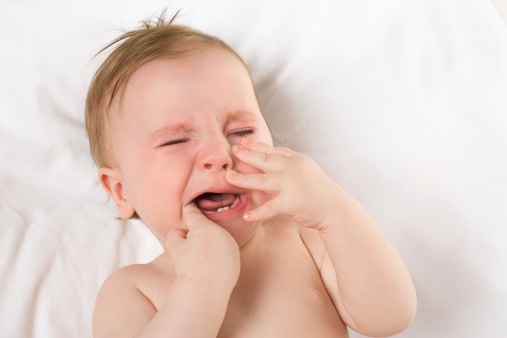When the baby teeth erupt through the gum tissue, the process is known as teething. Every baby’s experience is different, and the same baby might react very differently depending on which tooth is erupting. Every once in a while, a new tooth might come in without much reaction from your baby at all. In general, though, babies tend to display some common symptoms of teething. Here are 4 tips for dealing with teething problems.

Know Your Timing
The majority of babies get their first tooth at roughly 4 to 7 months of age, and the last sometime before their third birthday. However, this is only a general estimate. Some babies get their first tooth as early as 3 months. If your baby is showing symptoms of teething, check for an emerging tooth, if it doesn’t seem to be “on schedule.”
Learn the Symptoms
One of the most common symptoms of teething is unusual irritability and fussiness, which may start 3 to 5 days before you can see the emerging tooth. It typically eases once the tooth breaks through the gums. Teething babies may also suffer from swollen gums, difficulty sleeping, lack of appetite, and drooling, and may try to bite or chew on their toys.
Understand the Treatments
Biting on something cold is the best way to soothe teething problems. Teething rings are a popular choice, but make sure yours contains nontoxic fluid, as some babies manage to bite through them. Another option is to freeze a clean, wet, rolled up washcloth for the baby to chew on. Be sure to monitor for choking and take the washcloth away when it thaws.
You can also rub down your baby’s gums gently with a sterile gauze pad. This is not only soothing, but keeps the irritated tissue fresh and clean. Over the counter pain relievers can ease soreness, but make sure that both the medication and the dosage are correct for your baby’s age and weight.
Take Care of the Teeth
As soon as you can see the first tooth, it is time to start brushing. Use a small, soft toothbrush, and ask your pediatrician when to add a drop of child-friendly toothpaste. Around age 2, your child can learn to spit, and can begin learning to brush her own teeth with help and a small smear of fluoridated toothpaste. Around age 3, your child should be fairly confident with tooth brushing, and is ready for an initial appointment with a child-friendly family dentist.
Teething is not fun, but knowing what to expect can help. Check for signs of an erupting tooth, provide something cold, but safe, to bite on, and take care of the child’s gums and emerging teeth. Before you know it, your child will have a full set of teeth.
Conveniently located in Woodbury, MN, Creekview Dental provides a progressive yet conservative approach to dental care. Our innovative, highly personalized procedures are focused on maintaining tooth structure and providing you with the healthy, beautiful smile you deserve. Call us today at 651-738-8204 to take the first steps on the road to better dental health.

